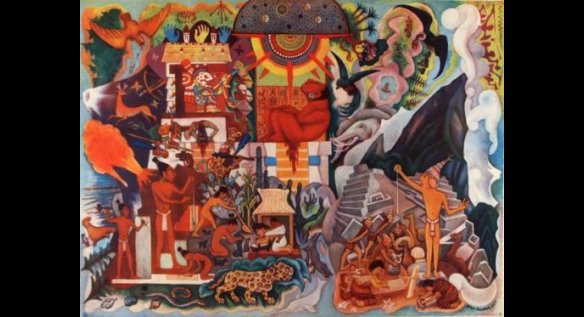Oda a Canto General
| Artist | : | Diego Rivera |
| Medium | : | Lithograph |
| Size unframed | : | 19.25"/14.25" |
| Size framed | : | N/A |
| Signature Info | : | Hand Signed |
| Frame Info | : | Yes |
| Condition | : | Fine |
| Year | : | 1950 |
Description
This is a Rare Hand Signed limited edition Lithograph "Oda a Canto General", by Diego Rivera.
Diego Rivera (Mexican, 1886 - 1957). "Oda a Canto General". Original color offset lithograph. 1950. Printed 1950. Signed and dated by Rivera in the matrix. Edition of 900, of which only a few survive. Full margins. Fine impression. Fine condition. Provenance: Ex-collection Jaled Muyaes, Mexico City. Extremely rare. Executed in 1950 by Rivera specifically for the front pastedown and front endpaper (one piece) for Pablo Neruda's famous "Canto General," pubished in 1950 by Neruda himself in Mexico City. The book, now itself exceedingly rare, was limited to 900 copies. There was a small overrun of the Rivera print (as well as the Siqueiros print used as the rear endpaper/pastedown) which Neruda gave to his close friend, Jaled Muyaes. Printed by Talleres Graficos de la Nacion in Mexico City. Please see the article "Del Pincel y la Palabra. Rivera, Neruda, Siqueiros" at https://revista.escaner.cl/node/3513 for more detail. Illustrated in “Diego Rivera, Gran Illustrador,” Mexico City: Museo Nacional de Arte, 2007, pp. 74-75. Image size: 14 1/4 x 19 1/4 in. (362 x 489 mm).
- Artist: Diego Rivera
- Title: "Oda a Canto General"
- Medium: Lithograph
- Year: 1950
- Edition: 900
- Size: 14 1/4 x 19 1/4 in. (362 x 489 mm)
- Signature: Hand Signed in Orange Crayon
- Authenticity: Letter from Auctioneers Attesting Authenticity
Born on December 8, 1886, in Guanajuato, Mexico, Diego Rivera sought to make art that reflected the lives of the Mexican people. In 1921, through a government program, he started a series of murals in public buildings. Some were controversial; hisMan at the Crossroads in New York City's RCA building, which featured a portrait of Vladmir Lenin, was stopped and destroyed by the Rockefeller family.
Early Life
Now thought to be one of the leading artists of the 20th century, Diego Rivera was born on December 8, 1886, in Guanajuato, Mexico. His passion for art emerged early on. He began drawing as a child. Around the age of 10, Rivera went to study art at the San Carlos Academy of Fine Arts in Mexico City. One of his early influences was artist José Posada who ran a print shop near Rivera's school.
In 1907, Rivera traveled to Europe to further his art studies. There, he befriended many leading artists of the day, including Pablo Picasso. Rivera was also able to view influential works by Paul Gaugin and Henri Matisse, among others.
Famous Muralist
Diego Rivera had some success as a Cubist painter in Europe, but the course of world events would strongly change the style and subject of his work. Inspired by the political ideals of the Mexican Revolution (1914-15) and the Russian Revolution (1917), Rivera wanted to make art that reflected the lives of the working class and native peoples of Mexico. He developed an interest in making murals during a trip to Italy, finding inspiration in the Renaissance frescos there.
Returning to Mexico, Rivera began to express his artistic ideas about Mexico. He received funding from the government to create a series of murals about the country's people and its history on the walls of public buildings. In 1922, Rivera completed the first of the murals at the Escuela Nacional Preparatoria in Mexico City.
Known for numerous dalliances with women, Rivera married fellow artist Frida Kahlo in 1929. He already had been twice before he wed Kahlo, who was 20 years his junior, and had several children from his past relationships. Rivera and Kahlo shared an interest in radical politics and Marxism.
Commerical Success
In the 1930s and '40s, Diego Rivera painted several murals in the United States. Some of his works created controversy, especially the one he did for the Rockefeller family in the RCA building in New York City. The mural, known as "Man at the Crossroads," featured a portrait of Russian Communist leader Vladimir Lenin. The artist had reportedly included Lenin in his piece to portray the turbulent political atmosphere at the time, which was largely defined by conflicting capitalist and socialist ideologies and escalating fears surrounding the Communist Party. The Rockefellers disliked Rivera's insertion of Lenin and, thusly, asked Rivera to remove the portrait, but the painter refused. The Rockefellers then had Rivera stop work on the mural.
In 1934, Nelson Rockefeller famously ordered the demolition of "Man at the Crossroads." Publish backlash against the Rockefellers ensued; after long proclaiming a deep dedication to the arts, the powerful family now looked both hypocritical and tyrannical.


